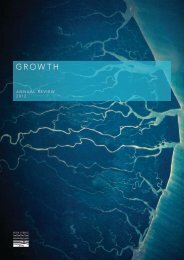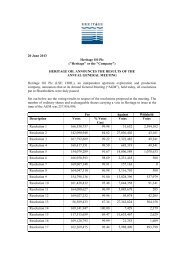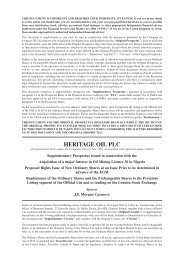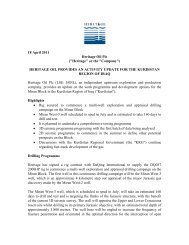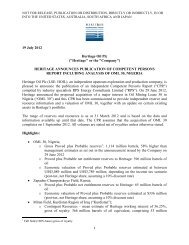Prospectus re Admission to the Official List - Heritage Oil
Prospectus re Admission to the Official List - Heritage Oil
Prospectus re Admission to the Official List - Heritage Oil
You also want an ePaper? Increase the reach of your titles
YUMPU automatically turns print PDFs into web optimized ePapers that Google loves.
RPS Energy<strong>Heritage</strong> <strong>Oil</strong> – Competent Persons Report4.1. Data AvailableData from <strong>the</strong> surrounding fields was sparse because competi<strong>to</strong>r data is proprietary. A variety of data wasavailable for this <strong>re</strong>view. Seismic data coverage (2006 survey and <strong>the</strong> older data) comprising 2D lines shotat fairly wide spacing. A number of Russian drilled wells with Russian style wi<strong>re</strong>line logs limited <strong>to</strong> SP,Conductivity and <strong>the</strong> Russian BKZ gradient (lateral) logs with 2.25 electrode spacing. Two new wells havebeen drilled in 2007 (P3 and P2) and a third (P4) was finishing drilling when this <strong>re</strong>port was beingp<strong>re</strong>pa<strong>re</strong>d. New wells drilled in 2007 by <strong>Heritage</strong> have modern western-style logs.DST data from new wells, summaries of <strong>re</strong>servoir simulation studies and production data from Wells 226and P3 we<strong>re</strong> provided.4.2. Geology4.2.1. Regional SettingThe Upper Jurassic sequence in <strong>the</strong> Zapadno Chumpasskoye Licence is unders<strong>to</strong>od <strong>to</strong> comprise asequence of shallow marine clastics, which a<strong>re</strong> widely deposited in <strong>the</strong> West Siberian Basin. The UpperJurassic is some 60 <strong>to</strong> 70 meters thick and includes a lower section of clays<strong>to</strong>nes and upper sand sequenceinterbedded with silts<strong>to</strong>nes and clays<strong>to</strong>nes. The Upper Jurassic in <strong>the</strong> a<strong>re</strong>a is overlain by <strong>the</strong> BazhenovFormation, a 20 <strong>to</strong> 25 met<strong>re</strong> thick bituminous shale which is both <strong>the</strong> source and <strong>the</strong> cap rock for<strong>the</strong> <strong>re</strong>servoir.The six fields surrounding Zapadno Chumpasskoye a<strong>re</strong> also <strong>re</strong>ported <strong>to</strong> be producing from <strong>the</strong>Upper Jurassic.4.2.2. Zapadno Chumpasskoye FieldThe data from Russian drilled wells available for evaluating net sand, net pay and fluid contact is limited <strong>to</strong>SP, Conductivity and <strong>the</strong> Russian BKZ gradient (lateral) logs with 2.25 electrode spacing. These a<strong>re</strong> low<strong>re</strong>solution <strong>to</strong>ols and <strong>the</strong> <strong>re</strong>sistivity logs a<strong>re</strong> unfocused. The<strong>re</strong> a<strong>re</strong> no porosity logs. The SP logs we<strong>re</strong>normalised <strong>to</strong> enable a consistent comparison of sand quality between wells. Net sand was initially pickedat a typical VCL cut-off 50 per cent. However, <strong>to</strong> compensate for <strong>the</strong> low <strong>re</strong>solution of <strong>the</strong> SP and <strong>the</strong>p<strong>re</strong>sence of thin beds, a higher VCL cut-off was accepted for <strong>the</strong> thinner layers (i.e. thickness less than5m). The Russian lateral logs we<strong>re</strong> <strong>re</strong>viewed for evidence of hydrocarbons in <strong>the</strong> wells and <strong>to</strong> determine<strong>the</strong> fluid contacts. The log <strong>re</strong>sponse is asymmetrical and only a qualitative interp<strong>re</strong>tation was possible. Theshallower hydrocarbon bearing sands we<strong>re</strong> found <strong>to</strong> indicate <strong>re</strong>sistivities approaching and exceeding40 Ohmm, whe<strong>re</strong>as <strong>the</strong> deeper formation closer <strong>to</strong> <strong>the</strong> hydrocarbon-water contact tended <strong>to</strong>wards15 Ohmm. The <strong>re</strong>sistivity measu<strong>re</strong>ments in some of <strong>the</strong> thinner sands we<strong>re</strong> uncertain due <strong>to</strong> poorlog <strong>re</strong>solution.New wells drilled in 2007 by <strong>Heritage</strong> have modern western-style logs.Prior <strong>to</strong> <strong>the</strong> new wells, <strong>Heritage</strong> p<strong>re</strong>sented a cor<strong>re</strong>lation of <strong>the</strong> upper part of an Upper Jurassic clasticsequence based on lithostratigraphy (no biostratigraphic data is available). Two sands<strong>to</strong>ne intervals (<strong>the</strong>Upper and Lower J 1 Sands<strong>to</strong>nes) we<strong>re</strong> identified in <strong>the</strong> upper part of <strong>the</strong> sequence and cor<strong>re</strong>lated betweenmost of <strong>the</strong> wells using <strong>the</strong> SP logs. These occur below <strong>the</strong> base of <strong>the</strong> ‘low conductivity zone’, equating <strong>to</strong><strong>the</strong> Bazhenov shale which is <strong>the</strong> seal and source rock for <strong>the</strong> Jurassic <strong>re</strong>servoirs. The cor<strong>re</strong>lation has been<strong>re</strong>vised based on data from <strong>the</strong> 2007 wells and additional older well data that has become available<strong>to</strong> <strong>Heritage</strong>.The <strong>re</strong>vised interp<strong>re</strong>tation suggests that <strong>the</strong> Upper J 1 Sand is very localised and no volumes a<strong>re</strong> nowassigned <strong>to</strong> this sand. Well spacing is large in this licence (between 2 and 7 km) and lateral variations insand content and quality, plus sand pinch-outs and amalgamations a<strong>re</strong> likely <strong>to</strong> occur within such distances.The model of pinch-out of <strong>the</strong> Upper Sand on <strong>to</strong> <strong>the</strong> high in <strong>the</strong> south is a <strong>re</strong>asonable interp<strong>re</strong>tation of <strong>the</strong>logs and is supported by evidence from well P2.Seismic data quality in this licence is of moderate quality; however <strong>the</strong> f<strong>re</strong>quency content of <strong>the</strong> data at<strong>re</strong>servoir level is insufficient <strong>to</strong> define <strong>the</strong> <strong>re</strong>servoir thickness. Effectively <strong>the</strong> only p<strong>re</strong>sently perceived usefor <strong>the</strong>se data is <strong>to</strong> define <strong>the</strong> structu<strong>re</strong> at <strong>the</strong> <strong>to</strong>p of <strong>the</strong> <strong>re</strong>servoir sequence which is seen <strong>to</strong> be a simplenorth-westerly dipping surface.<strong>Heritage</strong> provided depth structu<strong>re</strong> maps at Top Upper Sand levels. Seismic data have been <strong>re</strong>viewed;seismic survey data coverage comprises 2D lines shot at fairly wide spacing. No faults a<strong>re</strong> shown on <strong>the</strong>94



